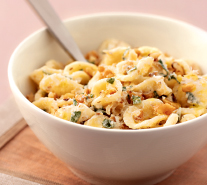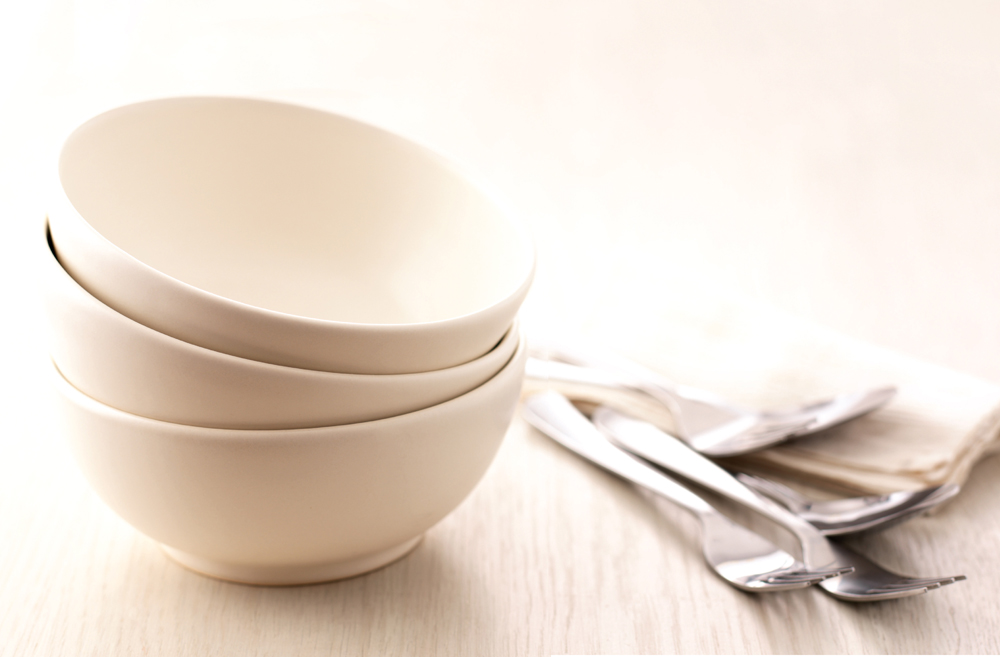
Pasta might be a traditionally Italian dish but it’s not surprising that people all around the world have embraced it as a firm favourite, often eating pasta one or more times a week. Pasta is the ultimate convenience food: quick and easy to prepare, extremely versatile due to the numerous pasta shapes and sauce combinations possible and suitable for any occasion, be it a weekday meal or a sophisticated dinner party.
People often have the misconception that fresh pasta is superior or somehow more sophisticated than dried. This couldn’t be further from the truth. Fresh pasta is reserved for specific shapes and sauces, and is most frequently eaten in central and northern Italy.
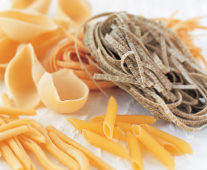
In certain regions of southern Italy, such as Sicily, people who eat pasta every day might never even have tasted it fresh! Unless otherwise specified, the recipes in this book use dried pasta. However, where bought filled pasta is required, always use the fresh variety.
Buying fresh pasta from a supermarket can lead to disappointing results. Gluey texture and blandness are all too common, so take the time to search out a good Italian deli, where the pasta is made daily and the best ingredients are used for the job. You’ll find a recipe for traditional flour-and-egg-based pasta dough on page 10 and the final chapter in the book (see pages 216–235) is dedicated entirely to homemade pasta recipes.
Dried pasta can be made with or without egg, using durum wheat and/or soft wheat flour. The choice of shapes and brands can be mind-boggling, so below is a useful guide to what shapes to choose for different sauces. When it comes to brands, it is best to go for Italian. These products are widely available, and the ingredients and expertise that go into their production make them far superior to most supermarket brands.
Italians have strong opinions regarding the pastas that should be used with different sauces, and any general rule that tries to define the criteria to use when making your choice will invariably be compromised by a long list of exceptions. Ultimately, the best combination is the one that works for you, but the following suggestions can help you make an informed choice.
The hollow pasta shapes with ridges, such as conchiglie, penne, rigatoni or garganelli, or the twisted pastas, such as fusilli, are all ideal for catching tasty chunks. Alternatively, you can opt for one of the long, egg-based pastas, such as pappardelle, tagliatelle or fettuccine. The inclusion of egg makes the pasta more absorbent and this, together with the wide surface of these types of pasta, encourages the sauce to cling to the pasta. Chunky sauces tend just to slide off thin, long strands, such as spaghetti – that’s why a true Italian would never serve an authentic Bolognese sauce with spaghetti!
For the same reasons mentioned above, egg pasta is the perfect partner for cream- or butter-based sauces. However, these sauces are incredibly versatile and will also happily cling to most short pasta shapes, such as farfalle, fusilli or penne.
This is where long, thin dried durum wheat pasta, such as spaghetti or linguine, come into their own. They’re ideal for tomato, fish or vegetable sauces that use olive oil as their base ingredient. These pastas won’t absorb the oil (as egg pasta would), but instead get a lovely, silky coating of glistening sauce.
By following these few simple guidelines, you can ensure that your pasta is cooked to perfection, every time.
Cook your pasta in a very large saucepan, full of boiling water. This will give it plenty of space to expand into as it cooks and the movement created by the rolling boil will keep it from sticking. Giving the pasta a quick stir halfway through cooking will also help to keep the shapes or strands separate. You’ll need enough salt in the water to ensure that the cooked pasta does not taste bland, even before you add the sauce.
We’ve all heard this Italian expression for knowing when pasta is cooked, but if it’s never been explained clearly, it’s hard to know what to aim for. Al dente literally translates from the Italian as ‘to the tooth’, meaning that when you bite into the pasta, it should give on the outside but still retain a little bite in the centre. However, it should be cooked all the way through, with no raw, dry white pasta visible in the centre.
Italians always serve their pasta already coated in sauce, as opposed to having a plate of plain pasta with a spoonful of sauce over it. This ensures that all the pasta is well coated in just the right amount of sauce for that particular dish. Many of the recipes in the book instruct you to reserve some of the cooking water from the pasta, combine the drained pasta with its sauce over heat, then add some of the reserved cooking water. This might seem odd at first, but there is a simple explanation. Italians only use enough sauce to lightly coat their pasta. Adding the starchy cooking water and stirring it over the heat encourages the sauce to cling better to the pasta, giving it a rich, silky quality that it wouldn’t otherwise achieve.
You shouldn’t think of making your own pasta as a daunting task. In fact, it’s much less prone to disaster than pastry making. You will, however, need some practice to become completely comfortable with the process, so avoid making pasta for the first time when you are expecting important guests!
The recipes in this book call for a 1-, 2- or 3-egg quantity of pasta. Make sure that you check the quantity needed before starting.
1-egg pasta dough
Makes about 150 g (5 oz)
75 g (3 oz) Italian 00 flour or fine plain flour, plus extra for dusting
25 g (1 oz) semola di grano duro, plus extra for dusting
1 egg
2-egg pasta dough
Makes about 300 g (10 oz)
150 g (5 oz) Italian 00 flour or fine plain flour, plus extra for dusting
50 g (2 oz) semola di grano duro, plus extra for dusting
2 eggs
3-egg pasta dough
Makes about 400 g (13 oz)
225 g (7½ oz) Italian 00 flour or fine plain flour, plus extra for dusting
75 g (3 oz) semola di grano duro, plus extra for dusting
3 eggs
Combine the flour and semola in a large bowl. Make a well in the centre and break in the eggs. Mix in the eggs with your fingers, slowly drawing in the flour as you go. Once the central mixture becomes too thick to handle, use the heel of your hand and knead to bring the mixture together. Alternatively, put all the ingredients in a food processor and pulse until combined.
Tip the dough on to a clean work surface dusted with Italian 00 or fine plain flour and knead for 3–4 minutes until it becomes smooth and elastic. Wrap in clingfilm and chill for at least 30 minutes, or up to 4 hours.
Dust your work surface with Italian 00 or fine plain flour. Set up a pasta machine at the largest opening. Cut the pasta dough into lemon-sized pieces and pick up one piece, keeping the remaining dough covered with clingfilm. Shape the dough you’re holding roughly into a rectangle and run it through the machine. Fold the dough in half widthways and then run it through the machine again. Lower the setting on the machine by one notch and run the dough through it again.
Continue running the dough once through each setting until you have gone through all the settings. If while you’re working you find that the pasta sheet is getting too long to handle, cut it in half and run one half through at a time. If it becomes sticky and catches in the pasta machine, dust with a little Italian 00 or fine plain flour.
Lay the pasta sheet on a surface dusted with semola, then cover with a tea towel while you roll out the remaining dough.
Don’t waste any time when shaping your rolled-out pasta – the dough will dry incredibly quickly, so work with all speed while it’s still moist and pliable.
Don’t worry about taking out your ruler – lasagne sheets can be cut out to suit the size of your baking dish. You can use a large, sharp knife or a crinkle cutter.
To turn your pasta sheets into pappardelle, tagliatelle, fettuccine or tagliarini, first cut the sheets into approximately 20 cm (8 inch) lengths. You can then run them through the pasta cutting attachment of your pasta machine: most will have a cutting attachment approximately 1 cm (½ inch) wide for fettuccine or tagliatelle and 5 mm (¼ inch) wide for taglierini.
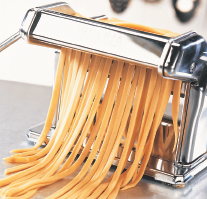
If cutting your pasta by hand, dust the pasta sheet with Italian 00 or fine plain flour and fold it in half lengthways. Dust and fold again, then once again. Using a large, sharp knife, cut into 2.5 cm (1 inch) widths for pappardelle, 1 cm (½ inch) widths for tagliatelle or fettuccine and slightly tricky 5 mm (¼ inch) widths for taglierini.
Instructions for cutting pasta for filled pasta shapes are included in the relevant recipes.
There are only a few items that are either essential or very useful when cooking pasta or making homemade pasta and gnocchi.
You cannot cook pasta properly in a small saucepan! You’ll need a large enough saucepan so that the pasta has plenty of space to move around in the boiling water while cooking.
Once it’s al dente, you’ll want to drain your pasta very quickly. A large colander that you can sit in your sink is much more efficient than a sieve for this purpose.
These are great for scooping delicate filled pasta or gnocchi from the pan, rather than draining them. They are also great for serving short pasta shapes.
These make it easy to toss long pasta such as spaghetti or linguine into their sauces. They’re also great for picking up the pasta when serving. Be gentle when using tongs with fresh or homemade pasta, otherwise the delicate pasta could tear.
This is used for cutting pasta sheets into lasagne sheets and/or ravioli shapes. This gadget is not essential, but it makes the job easy and adds an attractive zigzag pattern to the pasta.
This piece of equipment is essential for achieving the light, fluffy, lump-free mash needed for gnocchi. Even if you don’t make gnocchi very often, these cheap tools can be used for any recipe where ingredients need to be mashed.
These are inexpensive and make light work of the otherwise tough job of rolling out the pasta dough by hand with a rolling pin. The attachments that cut the pasta sheets into fettuccine, tagliatelle or taglierini are also great time-savers.
The following is a quick guide to the main ingredients used in classic Italian pasta dishes.
There are different grades of olive oil. Extra virgin olive oil is made from the first cold pressing of olives and its rich flavour can vary from peppery to nutty or grassy. For best results, use extra virgin in recipes where the oil is not cooked or where it features as one of the main ingredients. Regular, commercially produced and less expensive olive oil is the appropriate choice in recipes where the oil is used for frying or sautéeing vegetables at the beginning of cooking.
There is an abundant variety of tomatoes available in Italy in summer, from juicy plum tomatoes to sweet cherry tomatoes and green salad tomatoes. Each variety has its own use and it’s the San Marzano plum tomatoes that are prized for making sauces. These are the tomatoes most commonly used for canning – either chopped or whole. Good-quality canned tomatoes should not be frowned upon and Italians happily use them in winter to make their sauces. In fact, it is far preferable to use canned tomatoes than unripened, acidic greenhouse tomatoes! Passata is smooth, raw, puréed tomatoes sold bottled or in cartons to use in cooking.
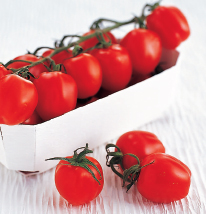
If a recipe calls for skinning tomatoes, place the tomatoes in a heatproof bowl and pour in enough boiling water to cover them. Leave for 30 seconds until the skin has loosened, then drain. Cut a small cross at the base of each tomato and pull away the skin.
Mozzarella This can be made from cows’ milk or water buffalo milk (mozzarella di bufala). Cows’ milk mozzarella is more than adequate to use in cooking when it’s going to be melted, but if you’re planning to eat your mozzarella in a pasta salad, it’s worth splashing out on buffalo mozzarella, as it tastes fresher and creamier. Only buy mozzarella kept in water. Parmesan Parmigiano Reggiano is a cows’ milk cheese made in Emilia Romana. It’s extensively used grated or shaved onto pasta. Grana Padano is very similar to Parmesan cheese and is a more economical choice for use in cooking.
Pecorino This is sheep’s milk cheese made in central and southern Italy. There are different varieties, which can be aged until they are ready for the table or matured further until dry and crumbly, to be used grated in cooking. The recipes in this book call for crumbly pecorino, often labelled Pecorino Romano. Ricotta This is a naturally low-fat soft cheese made from the whey left over from cheese making. The whey is reheated, then strained into baskets to drain, hence the name ricotta, which means ‘re-cooked’. The most commonly found ricotta outside Italy is made from cows’ milk and it’s the one recommended for the recipes in this book.
Fontina This is a mild cheese from Piedmont, which melts evenly and smoothly, making it perfect for cooking.
Gorgonzola and dolcelatte Both these blue cheeses are frequently used in pasta sauces. Gorgonzola is the strongest, comparable to a Stilton or a Roquefort. Dolcelatte is much creamier and milder, so a better choice when making a more delicate sauce. Mascarpone This full-fat, very thick cream cheese is mild with a rich, smooth texture.
Prosciutto is the generic Italian word for ham. Prosciutto crudo (literally meaning ‘raw ham’) is the most commonly known Italian ham, of which the most famous variety is Prosciutto di Parma (or Parma ham). It’s a raw ham cured in salt, then hung to dry and age.
Speck, a smoke-cured ham from the northern borders of Italy, is also used in this book. It has a robust, smoky flavour. Black Forest ham could be used as an alternative.
The most widely available wild mushrooms in Italy are porcini, chanterelles and girolles. Even during their season in autumn, Italians often use dried mushrooms, which need soaking in hot water before cooking. Of these, porcini are the most popular. Make sure that you use the soaking water from mushrooms, as it’s packed with flavour!
These small fish can be bought fresh or preserved in salt or oil. Salted anchovies taste fresher than those preserved in oil but will need thorough rinsing to remove the salt. The recipes in this book use preserved anchovy fillets rather than fresh.
These are small flower buds preserved in salt or vinegar. Soak them in cold water to remove the saltiness or sharpness from the vinegar before using. Small capers are generally more flavoursome than larger buds.
Italians generally use two types of soft wheat flour. They are graded as ‘0’ flour, which is similar to regular plain flour, and ‘00’, which is finer ground and the preferred choice for making fresh pasta. ‘00’ flour can be bought in Italian delis and some good supermarkets. Another flour commonly used is semola di grano duro, a durum wheat flour used in breads and pasta. It’s finer than the semolina generally used in other countries, so it’s worth buying it from Italian delis, especially for making silky smooth fresh pasta.
Use these listings to help you find the appropriate pasta dish to prepare.
Quickest-ever Tomato Pasta Sauce (page 136)
Orecchiette with Walnut Sauce (page 154)
Classic Basil Pesto (page 158)
Pesto Trapanese (page 178)
Pasta with Garlic, Oil & Chilli (page 166)
Pasta with Fresh Tomato & Basil (page 194)
Mascarpone & Mixed Herb Pasta (page 182)
Spaghetti & Courgette Frittata (page 210)
Spicy Tuna, Tomato & Olive Pasta (page 100)
Chicken & Tarragon Tagliatelle (page 56)
Fettuccine all’ Alfredo (page 168)
Aubergine & Rigatoni Bake (page 190)
Quick Pasta Carbonara (page 74)
Classic Bolognese (page 50)
Fettuccine with Pork Meatballs (see page 58)
Autumn Minestrone (page 18)
Chunky Chickpea & Pasta Soup (page 24)
Macaroni & Haddock Cheese (page 130)
Penne with Sausage & Tomato (page 68)
Fontina, Pancetta & Sage Gnocchi (page 78)
Wild Mushroom Pappardelle (page 146)
Farfalle with Smoked Salmon & Roe (page 122)
Rocket, Potato & Lemon Ravioli (page 220)
Duck Tortellini (page 222)
Open Seafood Lasagne (page 228)
Broad Bean & Goats’ Cheese Salad (page 30)
Spring Garden Pasta Salad (page 34)
Ricotta-baked Large Pasta Shells (page 200)
Tuna, Rocket & Lemon Conchiglie (page 88)
Linguine with Sea Bass & Tomatoes (page 104)
